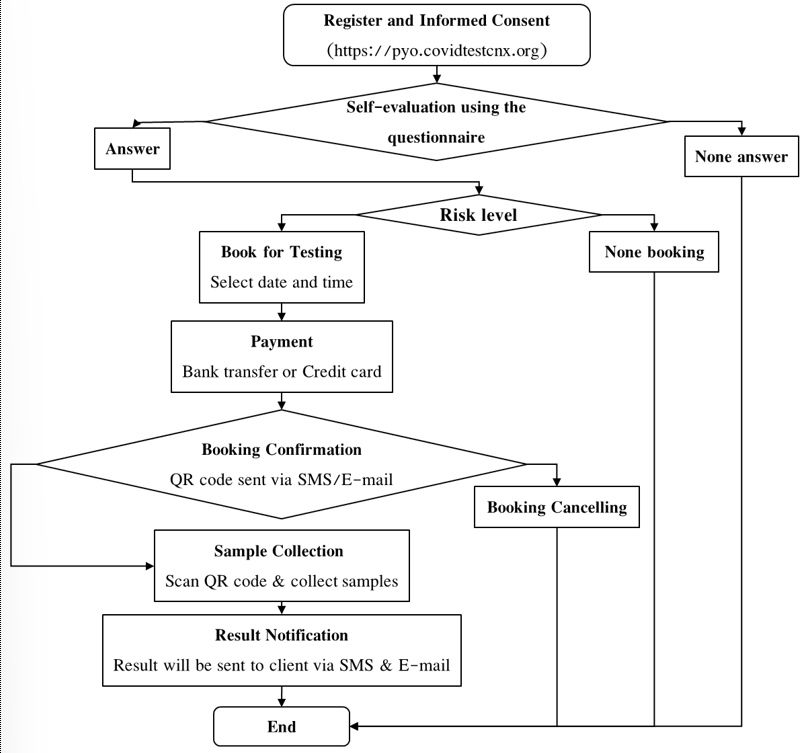COVID-19 proactive screening protocol during early outbreak using web-based application: Implementation in Thai Rural Area
Keywords:
COVID-19, Information system, Information technology, Testing management, ThailandAbstract
Coronavirus disease 2019 (COVID-19) caused by an infection with severe acute respiratory syndrome coronavirus 2 (SARS-CoV-2) has been recognized as one of the biggest problems to human health worldwide. The potential strategy to control the spreading of the virus is awareness of infection status, especially among non-patient under investigation (non-PUI). Additionally, implementing gathering control and suspending “social distancing” are key to a decrease in the chance of infection. This study aimed to conduct and implement the pilot management system for COVID-19 testing and to perform proactive screening test among non-PUI people in Phayao Province, the rural area of Thailand. This was a cross-sectional study. People who could access websites- or mobile applications were eligible to be recruited into the study. An online questionnaire was developed to collect information on socio-demographics, medical conditions and symptoms related to COVID-19 from participants who were living in Phayao Province from July to August 2020. 200 participants performed self-evaluation but only 143 (71.5%) participants booked an appointment and visited the collecting site to get the test. There were 25 (9%) participants being at high risk of infection. The nasopharyngeal/throat swabs were collected and proceeded to determine a presence of SARS-CoV-2 using RT-PCR. Of all, none was found to be positive for SARS-CoV-2. In conclusion, this developed management system would be an important tool for managing laboratory testing during the COVID-19 outbreak by means of reducing the chance of infection in the epidemic situation. This proactive screening system can also be applied for other medical testing and services.
References
Mahase E. Covid-19: WHO declares pandemic because of “alarming levels” of spread, severity, and inaction. BMJ. 2020;368:m1036.
Dechsupa S, Assawakosri S, Phakham S, Honsawek S. Positive impact of lockdown on COVID-19 outbreak in Thailand [Internet]. Vol. 36, Travel Medicine and Infectious Disease. 2020.
Department of Disease Control MoPH, Thailand. Case definition for patients under investigation (PUIs) with COVID-19 (edited on March 2, 2020). Thail Minist Publich Heal. 2020;21(1):1–9.
Department of Disease Control MoPH, Thailand. Guidelines for Clinical practice, diagnosis, treatment and prevention of healthcare-associated infection in response to patients with COVID-19 infection. Thail Minist Publich Heal. 2020;4(8):1–2.
Syangtan G, Bista S, Dawadi P, Rayamajhee B, Shrestha LB, Tuladhar R et al. Asymptomatic SARS-CoV-2 Carriers: A Systematic Review and Meta-Analysis. Front Public Heal. 2021;8:587374.
Oran DP, Topol EJ. Prevalence of Asymptomatic SARS-CoV-2 Infection: A Narrative Review. Ann Intern Med. 2020;173(5):362–7.
Johansson MA, Quandelacy TM, Kada S, Prasad PV, Steele M, Brooks JT et al. SARS-CoV-2 Transmission From People Without COVID-19 Symptoms. JAMA Net open. 2021;4(1):e2035057.
Bai Y, Yao L, Wei T, Tian F, Jin DY, Chen L et al. Presumed Asymptomatic Carrier Transmission of COVID-19 [Internet]. JAMA - Journal of the American Medical Association. American Medical Association; 2020;323:1406–7.
Yu X, Yang R. COVID-19 transmission through asymptomatic carriers is a challenge to containment [Internet]. Influenza and other Respiratory Viruses. Blackwell Publishing Ltd; 2020;14:474–5.
Yu C, Zhou M, Liu Y, Guo T, Ou C, Yang L et al. Characteristics of asymptomatic COVID-19 infection and progression: A multicenter, retrospective study. Virulence. 2020;11(1):1006–14.
Qian M, Jiang J. COVID-19 and social distancing [Internet]. Journal of Public Health. Springer; 2020; 1.
Matrajt L, Leung T. Effectiveness of Social Distancing for COVID-19. CDC. 2020;26(8).
Moosa IA. The effectiveness of social distancing in containing Covid-19. Appl Econ. 2020;52(58):6292–305.
Intawong K, Olson D, Chariyalertsak S. Application technology to fight the COVID-19 pandemic: Lessons learned in Thailand. Biochem Biophys Res Commun. 2021;534:830–6.
Whitelaw S, Mamas MA, Topol E, Van Spall HGC. Applications of digital technology in COVID-19 pandemic planning and response. The Lancet Digital Health. Elsevier Ltd; 2020;2:e435–40.
Almalki M, Giannicchi A. Health Apps for Combating COVID-19: Descriptive Review and Taxonomy. JMIR mHealth uHealth. 2021;9(3).
Department of disease control, Ministry of public health. Criteria for Coronavirus 2019 investigation of patients under investigation: PUIs) and Disease investigation for PUIs [Internet]. 2020.
Department of disease control, Ministry of public health. Guidelines for surveillance and investigation of Coronavirus Disease 2019 (COVID-19) [Internet]. 2020.
WHO. How a Strong Health System Fights a Pandemic. 2020;(September).
Da An Gene. Instructions for use for Detection Kit for 2019 Novel Coronavirus (2019-nCoV) RNA (PCR-Fluorescence Probing). Sun Yat-sen University. 2019;4(1):75–84.

Downloads
Published
How to Cite
Issue
Section
License
Copyright (c) 2023 Naresuan Phayao Journal

This work is licensed under a Creative Commons Attribution-NonCommercial-NoDerivatives 4.0 International License.
ผู้นิพนธ์ต้องรับผิดชอบข้อความในบทนิพนธ์ของตน มหาวิทยาลัยพะเยาไม่จำเป็นต้องเห็นด้วยกับบทความที่ตีพิมพ์เสมอไป ผู้สนใจสามารถคัดลอก และนำไปใช้ได้ แต่จะต้องขออนุมัติเจ้าของ และได้รับการอนุมัติเป็นลายลักษณ์อักษรก่อน พร้อมกับมีการอ้างอิงและกล่าวคำขอบคุณให้ถูกต้องด้วย
The authors are themselves responsible for their contents. Signed articles may not always reflect the opinion of University of Phayao. The articles can be reproduced and reprinted, provided that permission is given by the authors and acknowledgement must be given.







